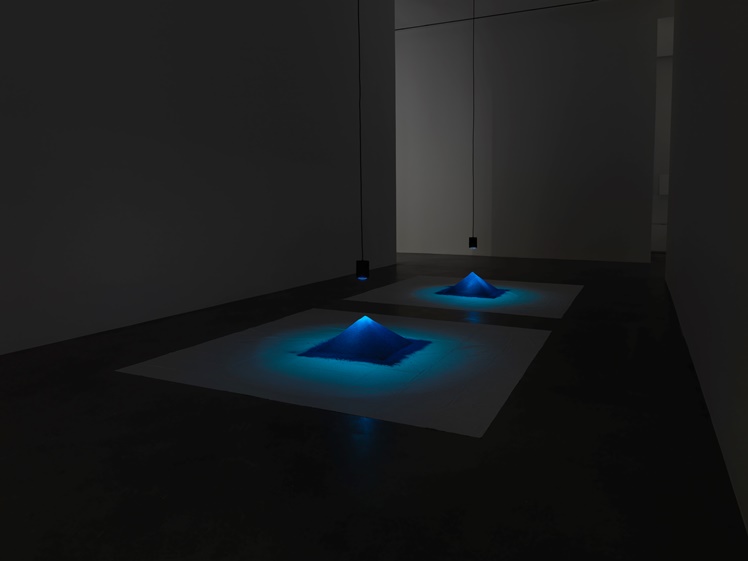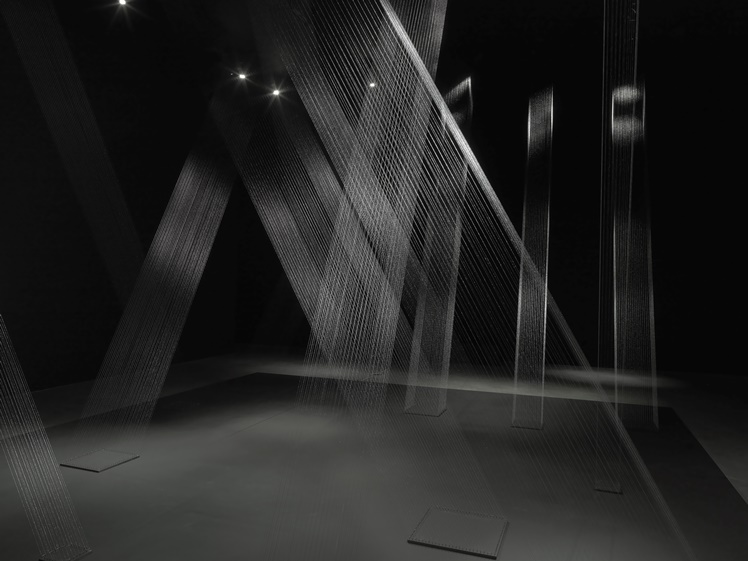The curatorial and editorial project for systems, non-
©Copyright Patrick Morrissey and Clive Hancock All rights reserved.
Lygia Pape
at Hauser & Wirth, Savile Row, London W1S 2ET
23 Sep – 19 Nov 2016
Reviewed by Fiona Grady
Hauser & Wirth is one of the most interesting commercial galleries to visit in central
London; the curators use the gallery space inventively, regularly transforming the
galleries into beautiful installations on a par with any museum show. Lygia Pape’s
solo exhibition is no exception; when you see the blacked-
Walking into the exhibition, the first artwork you see is a film of a woman, Lygia
Pape, climbing out of a cardboard box on a beach. The film is intriguing; it feels
like an old family holiday home movie, but instead of building sandcastles, Pape
is breaking out of a paper structure as the waves lap around her. She seems to be
investigating her boundaries, with the box representing a physical marker of the
forms she presents in her practice. But why is she there, and what is she doing?
The deteriorated footage is gently calming; there is a sense of fun -
Lygia Pape (1927-
Ttéia n.7 (1991) Installation view 'Lygia Pape', Hauser & Wirth London, 2016 © Projeto Lygia Pape Courtesy Projeto Lygia Pape and Hauser & Wirth Photo: Ken Adlard
Moving into the gallery space, this can be seen in the first installation: Ttéia
n.7 (1991). The installation comprises two peaks of pigment, each sitting in neat
square-
Tecelar (1958). Woodcut print on Japanese paper 29.7 x 41.9 cm / 11 3/4 x 16 1/2 in. © Projeto Lygia Pape Courtesy Projeto Lygia Pape and Hauser & Wirth. Photo: Ken Adlard
Moving on from this piece, the next works on display are a selection of six woodcut prints, Tecelar, made between 1955 and 1958, and two ink drawings, Desenho (1961). The woodcuts are composed from blocks of black lines, with varied density and quality of line, creating different shapes and weighted forms. They have a raw, scraped quality, with the texture of the woodgrain exposed and reproduced on the delicate Japanese paper. The prints have an exploratory nature; they appear to be testing compositional planes and methods of implying motion. There is a balance between positive and negative space; each is given equal status, allowing the white of the paper to produce moving diamonds or triangles, depending on where your eyes focus.
These multiples aren’t dissimilar from the early woodcuts of Josef Albers, and the prints and drawings of Anni Albers. Despite working in different political and artistic climates, all three artists share a innate understanding of how to create movement though form. Their works extend the depth of the paper using simple drawing techniques to visualise more complex ideas. ‘Tecela’ in Portuguese translates as ‘weaver’, and this is appropriate in reference to Anni Albers’ work, but also gives us insight into Pape’s intentions. There are architectural references in some of the prints too; for example, one shows two arches, one turned on its head, the other with a lighter block behind it that acts a a wall, drawing the viewer into the paper plane. The prints generate a potential energy and a glimpse of the artist’s working method.
The central piece of the exhibition, set in the sectioned-
Ttéia 1C (2001 / 2016) Silver thread, wood, nails, light. Dimensions variable. © Projeto Lygia Pape Courtesy Projeto Lygia Pape and Hauser & Wirth. Photo: Ken Adlard
This exhibition provides an excellent overview of Pape’s practice through these four interlinked elements of her output. Ttéia 1C is the most dominant work, leaving a lasting impression, a sensory experience that leaves you feeling somewhat dazed when exiting into the real world. Although Pape’s work is on a grand scale, it prompts an emotional response through the simplicity and delicacy of its gestures. It demonstrates the understated, minimalist strengths of geometry that have the ability to fascinate and move the viewer.




This is evidenced further in the ink drawings, Desenho. Created a few years after the prints, they are a slightly different proposition. Again, they use line to form edges and create block shapes, but they are lighter and more reaching than the woodcuts. One of the drawings presents two sets of lines side by side, each finding alternative ways to fill the sheet of paper. The other drawing uses line to define space as well as to attempt to escape from it. These drawings are particularly interesting in comparison with the installation Ttéia 1C, which immediately follows them. In the context of this piece they can be seen as working studies that helped Pape to create her line drawings on a larger scale.
Desenho (drawing) (1961) Ink on Japanese paper 44.8 x 33 cm / 17 5/8 x 13 in. © Projeto Lygia Pape Courtesy Projeto Lygia Pape and Hauser & Wirth. Photo: Ken Adlard
Desenho (drawing) (1961) Ink on Japanese paper
45 x 33 cm / 17 3/4 x 13 in. © Projeto Lygia Pape Courtesy Projeto Lygia Pape and Hauser & Wirth. Photo: Ken Adlard


Installation view, 'Lygia Pape', Hauser & Wirth London, 2016. © Projeto Lygia Pape Courtesy Projeto Lygia Pape and Hauser & Wirth. Photo: Ken Adlard